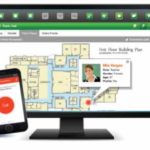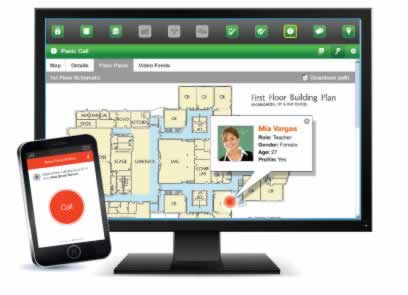These 10 products—targeting school safety, interactive teaching, student creativity, and more—captured our attention this month

An app that could reduce the response time in a school emergency, a device that uses the same technology guiding high-end cruise missiles to make any surface an interactive whiteboard, and online lessons that develop students’ creative thinking skills through filmmaking and other fun activities: These are among the latest ed-tech products announced in recent weeks.
Here are 10 new ed-tech products that have captured our attention this month.
Enhancing school safety
Research suggests that the average response time in a school shooting or other emergency situation is 18 minutes—but the incident is typically over in 12 minutes, says Todd Piett, chief product officer for Rave Mobile Safety.
Reducing the time it takes emergency personnel to respond could help save lives, and that’s the idea behind the company’s latest product, called Panic Button. It connects directly with the local 911 system and allows officials to share vital information in the event of an emergency.
When schools sign up for the service, they create a profile that includes floor plans, emergency response plans, a list of administrators to contact in an emergency, and a list of staff who are authorized to use the “panic button” app.
Staff members then register for the app and download it to their phones, and by tapping the large red button on their screen, they can initiate an emergency response. When this happens, the app speed-dials 911, and the caller’s profile automatically pops up on the operator’s screen, along with the caller’s location in the building.
At the same time, Rave is notified of the call, and the company alerts all administrators on the response chain, confirms that the 911 call was answered, and sends a link to a secure, private web page where administrators can view and share information about the crisis.
You don’t need a smart phone to use the service, Piett said; anyone from a school or district that subscribes can dial 911 using a cell phone or landline, and the service will still launch. The service is priced based on the number of handsets registered.
New teaching tools
A division of Interphase Corp., called penveu, has released a self-named gadget that reportedly uses the same technology behind high-end cruise missiles and smart bomb guidance to make any existing projector interactive and any surface or TV an interactive whiteboard—all in the palm of your hand, from anywhere in the room.
The penveu device works with any existing content and with both Apple and Microsoft devices, and it requires no calibration, special software, or licensing, the company says. Schools can buy the penveu for $499 for an 8GB model and $599 for a 32GB model.
“This is a product unlike any other currently on the market, and [it] certainly provides a viable alternative to those districts looking for innovative technology solutions that can accommodate all the disparate devices found in the classroom,” said Lynell Burmark, Ph.D. and CEO of educatebetter.org, in a press release. “It’s an especially timely tool for districts wanting to empower students making multimedia presentations as proof of learning under Common Core.”
Exo Labs is coming out with its second-generation microscope camera, which takes advantage of the Lightning connector for new iPads to deliver much higher frame rates than the original device.
Like the company’s original camera, the Model 2 attaches to a microscope, plugs into an iPad or iPhone, and includes an app that lets you stream images from the microscope, annotate them, take time-lapse photos, measure distances with the touch of your finger, and more.
With the original model, images were delivered from the microscope to the device at a rate of 15 frames per second. The Model 2 increases this speed fourfold, to 60 fps (the maximum refresh rate of an iPad screen) at the lowest-resolution setting, so “users won’t experience a lag between moving the slide around and what they see on the screen,” said Chief Technology Officer Jeff Stewart.
The Model 2 also uses a higher-quality image sensor, leading to a larger field of view, Stewart said. The Model 2, which works only with iPads that use a Lightning connector, will be available later this month for $495; Exo Labs will continue to sell its first-generation camera, which works with 30-pin iPads, for $395.
InFocus has introduced a 10-inch Windows Pro tablet with Microsoft Office 2013 and a price point that could be attractive to schools: $299 if purchased through InFocusStore.com.
The InFocus Q Tablet also includes four proprietary apps designed to facilitate sharing, viewing, and controlling content on the company’s Mondopad or an InFocus wireless-enabled projector, enhancing collaboration. These built-in apps include a tool called InFocus BigNote, which adds an interactive whiteboard to the Q Tablet with multi-colored pens and shapes for notes, sketches, and annotations that can be saved and shared.
The Q Tablet “empowers [students] to effectively participate in classroom discussions with the tablet’s annotation, file, and screen sharing from across the room,” said Dave Duncan, InFocus product manager. “It’s powerful, lightweight, [and] can run all the Windows 8.1 apps they need—all on a realistic … budget.”
A new division of SecurityWorks, GORILLAdigital, is focusing on the design and manufacture of creative, ultra-rugged IT support products. Its first such product is the KONGcart 2000 Series, an innovative audio-visual (AV) cart that accommodates a projector, a document camera, a tablet or laptop, and a sound system.
“Three school districts joined with us in a design project to reinvent the AV cart after teachers and administrators concluded that the old-style carts didn’t fit with today’s equipment,” said Christopher Meyer, president of SecurityWorks, in a press release.
All of the equipment on the cart is physically secured, yet fully adjustable and within easy reach, the company says. The KONGcart has built-in cylinders that allow the cart’s work surface to adjust from 29 inches to 42 inches while in use, allowing elementary school teachers to sit down while keeping eye contact with their students during instruction.
The KONGcart “holds up quite nicely in the high school environment, where many other products do not,” says Roxanne Ansolabehere, multimedia director for San Leandro High School in California, where there is a KONGcart in every classroom. “Teachers love the fact that the equipment is right at their fingertips and physically secured to the KONGcart, so they just push a button and get to teaching each morning.”
New curriculum products
An ed-tech startup called Lingua.ly, which offers a cross-platform solution that draws on a user’s environment and interests to create a personalized language learning experience for that user, has released a new web app that helps users learn a language while browsing the web.
Lingua.ly’s free WebApp turns websites, eMail messages, and Twitter feeds into an educational experience. Users sign up with an eMail, Google, or Facebook account, then choose the language they want to learn. As users read articles and messages online, they can double-click on words to have them read aloud, defined, and added to their “collection.”
The service, which is available for English, French, Spanish, Arabic, or Hebrew, also includes practice exercises and games designed to help reinforce the words in your collection. An Android app allows users to sync their collection with an Android-based device, and Lingua.ly is working on an iOS app as well.
Another ed-tech startup, TechSpaghetti, has launched an online curriculum called the Young Innovator’s Toolkit. It’s a series of lessons for children ages 6-12 that develop creative and higher-order thinking skills through fun digital media activities, such as creating films and dramatic soundtracks.
The curriculum “scaffolds children through the creative processes, technical skills, and learning involved with making a showpiece,” TechSpaghetti says. The lessons available in August are for Macs and iPads only; browser-based classroom lessons for other platforms will be available next year.
To help support the launch of its product, TechSpaghetti has created an Indiegogo crowdfunding campaign that lets contributors pre-order its lessons at discounted prices. The Indiegogo campaign will run until the July 22, with proceeds helping to fund the development of TechSpaghetti’s online platform.
LearnZillion has become known for its free library of videos showing exemplary Common Core teaching practices, as well as grade-specific videos demonstrating key concepts for students. Now, the company is offering a premium version of its service as well: For a per-building fee, schools and districts can buy more complete curricular resources for students in grades 2-12.
The premium version includes interactive math lessons and activities that can help teachers differentiate instruction; a close reading program with weekly “anchor texts” that balance literary and informational readings; and a writing program, called Write Along, that provides daily and weekly writing tasks for students.
LearnZillion Premium also includes high-quality professional development content and a digital collaboration platform, the company says.
Other new ed-tech products
A startup company called eCarrot has hit upon a creative way to control the amount of screen time children spend playing games and texting on their mobile devices: Its software lets students earn more screen time by answering a series of math questions first.
“We wanted to empower kids to take a more balanced approach [to using technology], based on the level of accessibility that a parent or teacher decides,” said CEO Patrick Grimes.
Most other parental control options on the market today are “very one-sided,” he said, taking away a child’s access or privileges. And even if parents use a wireless carrier to block their child’s access, the child could still use his or her school’s Wi-Fi network to connect. With eCarrot, “we’ve created an opportunity for the child to earn his or her [screen] time,” while practicing math skills and increasing computation speed at the same time.
An app for Android devices will appear in the Google Play store later this month, and the company is piloting a school-based version, called EduLock, in classrooms this fall. To participate in the pilot, send an eMail message to pgrimes@edulock.org.
Wasp Barcode Technologies, a provider of business productivity solutions, has announced new asset tracking systems for schools and universities: MobileAsset v7, designed to track IT equipment, and MobileAsset.EDU, designed to track how grant funds are spent.
These new solutions are Android and iPhone/iPad compatible, offer easy audit and report-pulling options, and already have saved numerous schools thousands of dollars, the company says.
For example, Miami Public Schools in Oklahoma now manages all its IT equipment—valued at more than $1.6 million—from one central database using MobileAsset v7. Implementing an asset tracking solution has reduced the district’s audit time by a staggering 93 percent, the company says.
- Can technology help schools prevent AI-based cheating? - April 14, 2023
- How to ensure digital equity in online testing - July 6, 2022
- ‘Digital skills gap’ threatens innovation - May 30, 2022


Comments are closed.